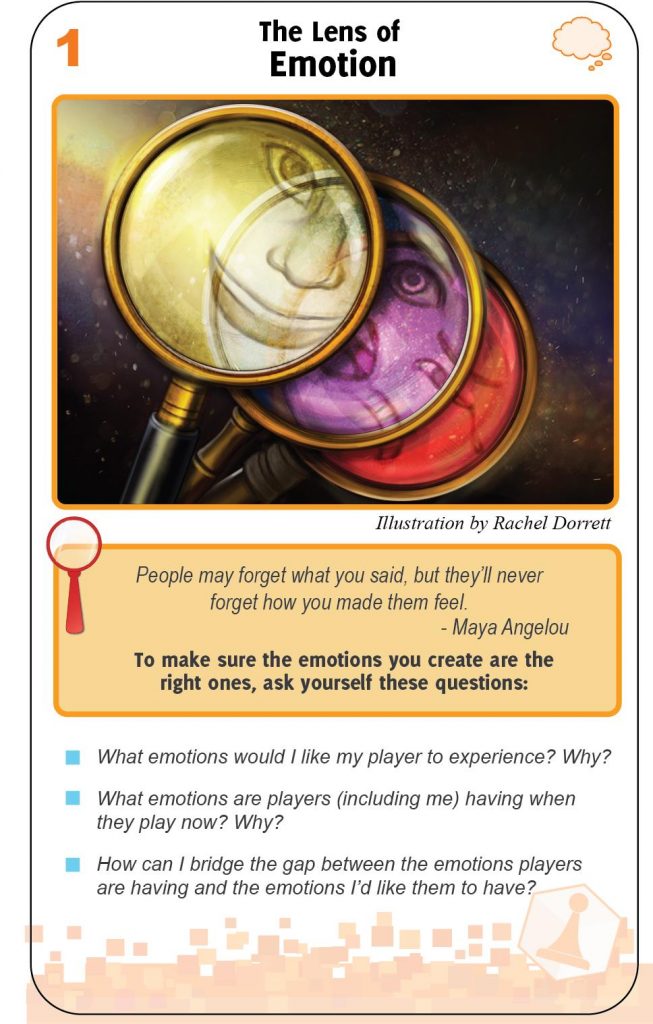To make sure the emotions you create are the right ones, ask yourself these questions:
-What emotions would I like my player to experience? Why?
-What emotions are players (including me) having when they play now? Why?
-How can I bridge the gap between the emotions the players are having and the emotions I’d like them to have?
As a Marriage and Family Therapist by day and a Game Designer by night, this first lens is an interesting intersect between my two worlds. I appreciate that Jesse Schell, author of The Art of Game Design: A Book of Lenses, starts with this particular lens. Emotions become the glue that attaches our experiences to our memories.
“I’ve learned that people will forget what you said, people will forget what you did, but people will never forget how you made them feel.”
― Maya Angelou
I remember playing an early prototype called the Prisoner’s Dilemma, designed by Jarom Higley BGDG of Utah member. There is a paradox that is called by the same name by Merrill Flood and Melvin Dresher back in 1950 (Short video explanation of The Prisoner’s Dilemma).
The game was relatively simple, a scenario would be read aloud to all players and two options would be offered to everyone. One option would be the most beneficial, but if too many people took that option then negative consequences ensued for each of those players, while the second option was safer but less beneficial. We could discuss, bargain and make non-binding promises but would ultimately submit our choices in secret. These choices were then revealed and players were awarded points according to their selections. Various scenarios followed this same pattern, though with vastly different stories and effects present. This game remains in my memory because of the emotionally evocative elements of the game! Betrayal, victory, friendship as well as a feeling of craftiness were all emotions that surged inside of me during this game.
In the final moments of the game I made an appeal to another player whom I’d helped out several scenarios before. He had a better chance of winning on his own, but it was not a guarantee. In a twist of fate he and I collaborated for a shared win over everyone else. The emotion of that moment is what cements that gaming experience in my mind and was a great teaching opportunity for me in the Art of Game Design.
When dealing with people, remember you are not dealing with creatures of logic, but with creatures of emotion.
-Dale Carnegie
Legacy games such as Pandemic Legacy or Clank Legacy stand out as a unique study of emotion in gaming for at least two reasons. First, the emotional experience with the game itself and second the emotional experience with the people around us.
![SPOILERS] Ryan Solos Pandemic Legacy [SPOILERS] --- DO NOT CLICK ...](https://cf.geekdo-images.com/medium/img/RAMKMjuXtbxgYzuIca-4ncvBQzI=/fit-in/500x500/filters:no_upscale()/pic2771643.jpg)
- The emotional experience with the game itself: There’s something visceral about tearing up a part of the game, writing on or placing permanent stickers or even opening up new boxes which reveal new elements to a game! Just the idea of knowing that the game will never be the same after I play it today will excite a part of the brain as the feeling of permanence in my interaction with the game plays out.
- The emotional experience with the people around us: When a game is going to be a one-shot, all or nothing, gaming experience then we are unlikely to play it with random or inconsistent people. In contrast, we will likely play the game with our family or a tight-knit gaming group. That alone is going to amplify or change our gaming experience! We are then more likely to have a more rich emotional experience due to the fact that we are with the people we most want to be with for this particular activity.
Social deduction games often have some evocative moments. I was recently watching a Ted Talk with Travis and Holly Hancock from Facade Games and one of the things they look for in their game development process is when people “scream”! This is one of the best illustrations to show their game is working!
This Lens of Emotion and the questions it asks are vital to understanding how game design interacts with player experience! If you want your game to be memorable and leave a lasting impression on your players then attempt to look at your game design through this lens a little more closely.

